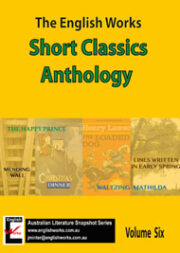Please read the story on p. 40. We’ll be tackling a range of writing tasks, including the reflective essay on p. 42. We’ll also draw upon ideas from other pieces in this Anthology as well as wider reading to construct an interesting essay.

The Blind Men
The blind men are curious about the elephants: a lot of people tell different stories about the elephant because they are such a unique animal.
They are surprised that the Rajah lets his daughter ride an elephant given the terrifying stories they hear. This appears to be rather contradictory.
Compare and contrast the different experiences. Include quotes in your evaluation.
Each blind men discuss their own opinions which vary considerably based on their own tangible experiences.
The six blind men all feel a different part of the elephant which leads to different conclusions. For example, the third blind man feels the “pointed tusk” and comes to the conclusion that the creature “is as sharp and deadly as a spear”. This conclusion differs from the fourth blind man’s who touches one of the legs and believes that the elephant is just a “large cow”.
In their own way, they are all are partly right, but they all firmly believe their own conclusions and dismiss the others.
Explain the tone and attitude of each of the blind men
Their experience depends upon which part of the elephant each one touches.
They become increasingly aggressive and forthright in defence of their opinions.
The fifth blind man dogmatically declares, “Magic carpet. There’s no doubt”. He refuses to countenance the second blind man’s opinion – that it is a “giant snake”.
The Rajah is incensed and questions each about their resolution and their confidence.
His advice to the blind men is to put all the pieces of the puzzle together which will give a more complete picture. They “will see the truth”.
What is the purpose of the ending? Explain the metaphoric journey home.
The blind men heed his advice and decide to “learn the truth”, by putting “all the parts together”.
In a way, their journey home – whereby each puts a “hand on his friend’s shoulder” – becomes a metaphor/symbol of the Rajah’s advice. In this case, each man is a part of the whole and it is by evaluating the various parts of the whole that one can glimpse the “truth”.
The proverb instructs us about the importance of learning from each other. Each one’s subjective experience is limited; by learning from each other, one gains a more comprehensive and vivid picture of the whole.
Guided essay task
Paragraph 1
Individuals see the world primarily through their own subjective experiences. They see, touch and feel objects and things which gives them an idea of who they are and what they are doing. This means that each of us tends to have a degree of bias in the way we see the world and interact with others. What does this mean?
Paragraph 2: similarities and differences among people because of their life experiences, cultural backgrounds, languages etc.
Write a list of all the factors that influence people’s views of the world; their habits; their mindset; their values; their mannerisms; their opinions.
Consider people’s different experiences which leads to different impressions of the truth.
- For example, you might see things differently from your parents, because of cultural factors and age factors.
- Eg. video games and technology; the younger generation has grown up with technology; the older generation did not grow up with computers. How does this affect one’s outlook on life? your experience of COVID; how does it vary from theirs?
- My grandparents love dancing; .. elaborate and explain. Because they have a lot of free time; the things they really like because they might be different from their place of origin.
Paragraph 3
People can gain a deeper insight into the truth by collaborating with each other.
Similar examples: people learn from their other’s mistakes.
Return to the English Works Short Classics